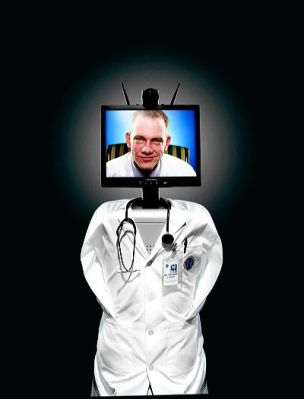Google Glass is here but its reality in the workplace is not quite here yet. What it will eventually do to the way we live and work reminds me of Steampunk illustrations of a person with a mechanical eye, who works according to what appears in the medium of the display, entirely programmed by software.
It’s a vision of man as a node, receiving and transmitting data. Just as the data center is one giant node so will we someday act in a similar way. We will use our unique capabilities to do certain forms of work, much of everything else automated, abstracted by machines that speak in their own language that they understand but we can’t.
Google Glass is the vision of a programmable human. In the future, it’s entirely possible that the eye will get connected to a new kind of brain, augmented to process large amounts of data streaming before us. We will communicate with each other and the networks that connect to different parts of our bodies; the people in our different relationships and the machines that we manage.
This all sounds quite freaky as I sit here listening to Chopin, pecking on my MacBook Pro, a cup of tea and my #phablet on the edge of the desk.
But consider that I am listening to music on Pandora streamed from some data center, and the concept of Google Glass and the ramifications of wearable computing do not seem so extreme. Pandora is an app based upon complex algorithms that uses the concepts of the ” human genome” to know what music to play. It will continue to play music that is similar to Chopin, based upon what I like and what other people listen to as well. The Note II beeps when I have a new message. The MacBook Pro is a stationary console of its own that I stare into for attaining some – any – form of wisdom.
To me, this shows that a future of man and data is already here but the past has to be dealt with in order for futuristic tools like Google Glass to have relevance.
Google Glass demonstrates how in business we will continue to use technologies of the future along with those of the past.
Consider the dynamics of today’s IT:
- Cloud computing makes business capabilities not previously possible. But these new models must take into account older technologies in order to be relevant. A classic example: the ability to run apps in older browsers.
- Compute, storage and networking advances will accelerate the advancement of data centers and the ability to process, store and analyze information. The challenge: adapt storage and networking hardware to newer, software-defined technologies.
- The new data factories of today allow rapid app development processes but still need connectors to older, on-premise application lifecycle management tools.
- Software is eating the world. We see this on a daily basis as fewer people manage ever-growing, scaled-out infrastructure using developer and operations practices. The practice has to correlate to methodologies developed for managing physical servers that often require far more IT resources.
- The devices we use are getting ever smaller. The PC is still relevant, but the smartphone is our console for managing our life and work. We need new kinds of mobile apps but have to manage the software on the PC, too.
And then consider the direction we are heading:
- The devices we use will disappear and become part of what we we wear. For now, we have to fit smartphones in our pockets and avoid using them when we drive.
- Eventually these devices will be embedded in our bodies and connected to the trillions of sensors in our world so we can do things we have dreamed of such as flying cars around the globe at hyper speeds. Really — we needed to connect the data before we can fly around like birds. But we will still have to deal with antiquated, on-the-ground transportation systems.
- Virtual assistants, such as the navigation assistant on Google Maps or Nuance Nina, will become ever more common. But people will still act as guides and customer-service reps.
- People will work remotely, not in the factories. They will be trained to manage the data from the machines. We see the first glimpses of this at Internet-scale data centers. But for some time to come, most factories will need lots of people to manage them.
But Google Glass will make its way, despite its current shortcomings:
- Use cases are a still a big question market yet augmented reality in the workplace seems more relevant than ever before with a wearable technology like Google Glass.
- Battery power is an issue that limits Google Glass capabilities but we know we can adapt so we can do things we never could before.
- There is no ecosystem for Google Glass, but we can expect that developers are right now creating the first generation of apps that will herald a new era in wearable computing.
- The devices are still in limited use. For that matter, so were smartphones at one time.
- Workflows need to evolve — how will the collaboration work? How will apps connect? Mobile workflows have just started to emerge with smartphones. Leaps to wearable devices will take time to understand. The reality will come when people need new ways to get their work done in ways not possible before.
- Cost needs to come down. It’s a certainty, though, that this will happen.
The vision for how Google Glass applies to business are numerous and mostly just blind speculation. It will change the way we live and work but only as much as we live and learn to adapt it to the items and ways of our past.
